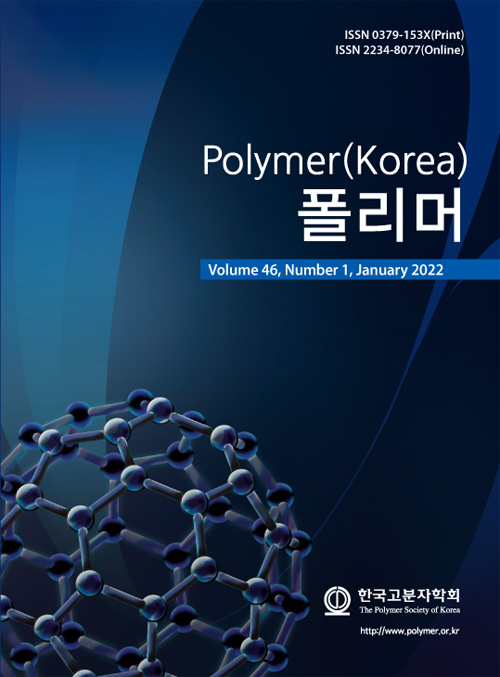- Preparation and Characterization of Polyurethane Using Cardanol-Based Bio-Polyol Obtained from One-Pot Synthetic Method
Department of Chemical Engineering, Kyonggi University, 154-42, Gwanggyosan-ro, Yeongtong-gu, Suwon 16227, Korea
- 한 단계 합성 방법을 통한 카다놀 기반 바이오 폴리올 합성 및 이를 이용한 폴리우레탄의 제조 및 특성
경기대학교 화학공학과
Reproduction, stored in a retrieval system, or transmitted in any form of any part of this publication is permitted only by written permission from the Polymer Society of Korea.
In this study, a cardanol based bio-polyol (CBP) was prepared via one-pot synthesis method. The synthesis of CBP was proceeded via Mannich reaction using cardanol, formaldehyde, and ethanolamine. The chemical structure of CBP was confirmed via 1H NMR and FTIR. Then, bio-polyurethane (CBPU) was prepared using CBP and hexamethylene diisocyanate (HDI). For the comparison experiments, polyethylene glycol (PEG), petroleum-based polyol, was applied to prepare a polyurethane (PEGU) as a control sample. From analyses results for TGA, UTM, chemical resistance test, and antibacterial test for CBPU and PEGU, it was found that CBPU showed higher tensile strength, chemical resistance, and antibacterial properties against E. coli compared to PEGU.
본 연구에서는 한 단계의 합성 방법을 통해 카다놀 기반 바이오 폴리올(CBP)을 합성하였다. CBP는 카다놀, 포름알데히드 수용액, 에탄올아민을 사용한 Mannich reaction을 통해 제조하였으며, 1H NMR과 FTIR 분석을 통해 CBP가 성공적으로 합성되었음을 확인하였다. CBP와 헥사메틸렌 디이소시아네이트(HDI)를 우레탄 반응하여 바이오 폴리우레탄(CBPU)을 제조하였으며, 폴리에틸렌글리콜(PEG)을 사용하여 제조한 석유계 폴리우레탄(PEGU)을 대조군으로 사용하여 TGA, UTM, 내화학성, 항균성에 대한 분석을 수행하였다. 이러한 분석 결과 CBPU는 CBP 고유의 화학적 분자 구조 차이를 바탕으로 대조군 PEGU와 비교하여 E. coli에 대한 높은 항균성과 우수한 내화학성 및 높은 인장강도를 가지고 있음을 확인하였다.
Keywords: cardanol, polyurethane, bio-polyol, antibacterial property, mechanical property.
- Polymer(Korea) 폴리머
- Frequency : Bimonthly(odd)
ISSN 0379-153X(Print)
ISSN 2234-8077(Online)
Abbr. Polym. Korea - 2023 Impact Factor : 0.4
- Indexed in SCIE
 This Article
This Article
-
2022; 46(1): 13-21
Published online Jan 25, 2022
- 10.7317/pk.2022.46.1.13
- Received on Aug 14, 2021
- Revised on Nov 8, 2021
- Accepted on Nov 8, 2021
 Correspondence to
Correspondence to
- Sang-Ho Cha
-
Department of Chemical Engineering, Kyonggi University, 154-42, Gwanggyosan-ro, Yeongtong-gu, Suwon 16227, Korea
- E-mail: sanghocha@kgu.ac.kr









 Copyright(c) The Polymer Society of Korea. All right reserved.
Copyright(c) The Polymer Society of Korea. All right reserved.